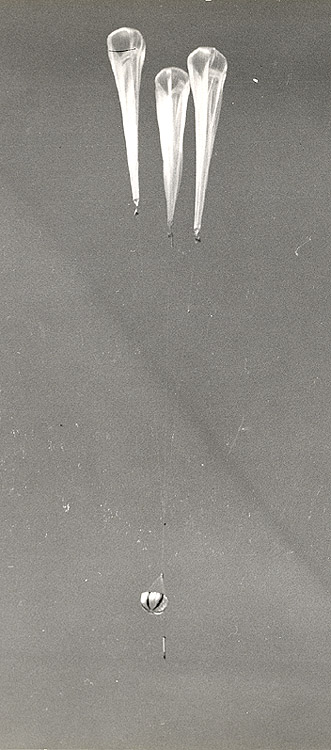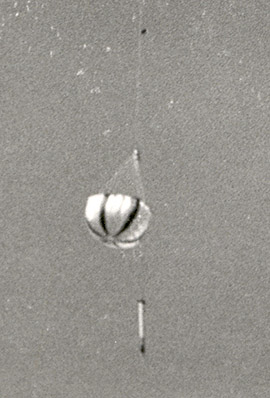Purpose of the flight and payload description
The FFTV system was a development impulsed by the Office of Naval Research Special Devices Center contracted with Cornell Aeronautical Laboratory (CAL) from Buffalo, to develop a free fall test system. On that times, supersonic wind tunnels were a scarce commodity in high demand so one alternative method of data-gathering was to drop test bodies equipped with experimental airfoils and other aerodynamic test equipment from high-altitude balloons.
By 1948 CAL already had considerable experience in working with supersonic models and projectile designs under military contract. The balloon-dropped projectile was given the designation 9UJ-1 Free Fall Test Vehicle (FFTV).
As the design of high altitude balloons was incipient at the time, and there were no balloons available of the size required, a cluster of three Skyhook plastic balloons, seventy-three feet in diameter when fully inflated, were used to lift the FFTV. The balloons were connected to the fifteen foot long projectile by a tether system. Drop altitude was planned to be about 100,000 feet. After being launched, in New Mexico the assembly would climb to altitude and drift over the White Sands Proving Ground range into a test area where optical and radar tracking systems could observe the test vehicle. The balloons could be tracked by radar even at 100,000 feet because their radar cross-sections were enhanced by RAWIN corner-reflectors (just visible at the base of each balloon in the photo below). When it was in the proper location, the FFTV would be cut loose from the balloons by radio command and would begin its supersonic descent.
The picture at right correspond to a test carried out on April 29, 1949 and is the only known picture of the system in flight. The inverted parachute shown near the test vehicle was used to slow down the rate of climb of the balloons in the initial stages of the ascent.
Details of the balloon flight
Balloon launched on: 4/29/1949
Launch site: Holloman Air Force Base, Alamogordo, New Mexico, US
Balloon launched by: Holloman Balloon Branch
Balloon manufacturer/size/composition: Zero Pressure Balloon General Mills 3 x 73 foot
End of flight (L for landing time, W for last contact, otherwise termination time): 4/29/1949
Landing site: In the White Sands Proving Ground range, New Mexico, US
External references
- The Arrey Sighting at NICAP web site
844If you consider this website interesting or useful, you can help me to keep it up and running with a small donation to cover the operational costs. Just the equivalent of the price of a cup of coffee helps a lot.



